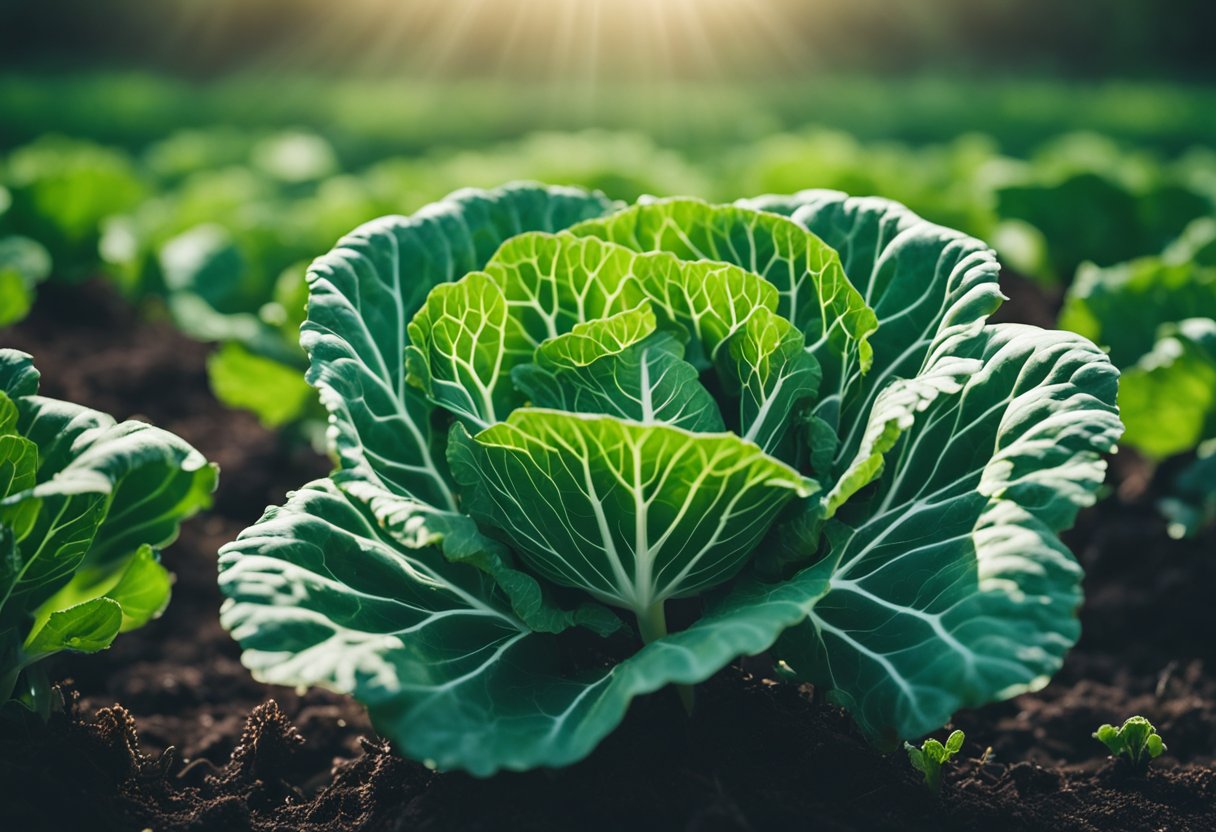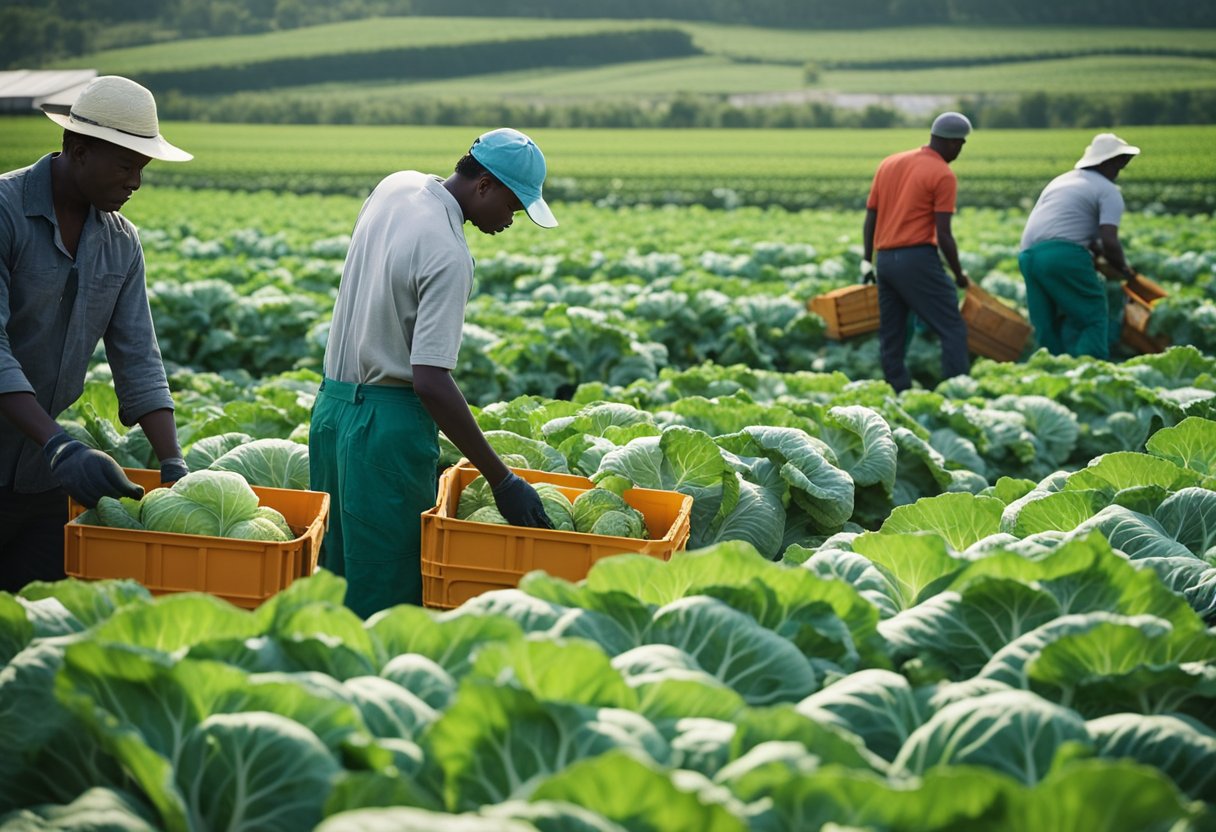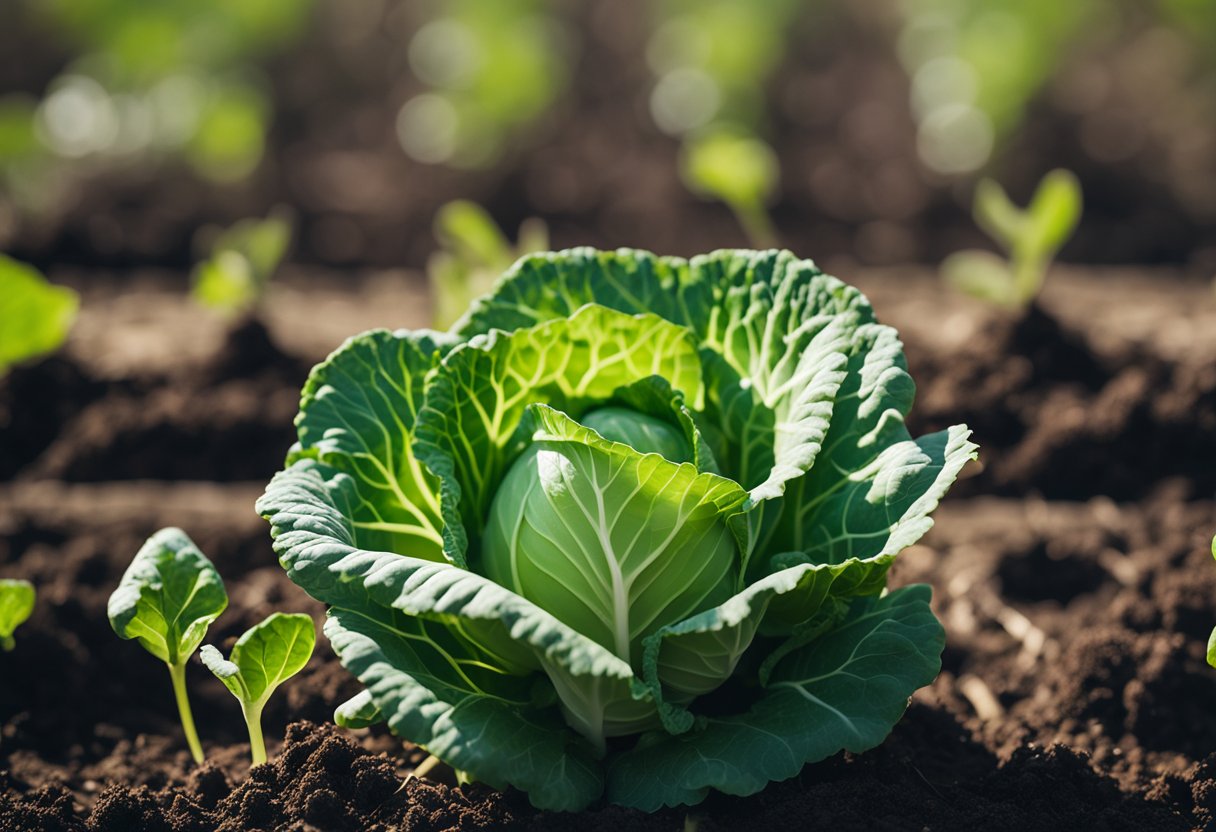Cabbage is a cool-season crop that is easy to grow and a great addition to any vegetable garden. However, to successfully grow cabbage, it’s important to understand its life cycle and Cabbage Plant Growth Stages. Cabbage is a biennial crop that completes its life cycle in two years, but it is harvested during the first year before it has a chance to go to seed.

The cabbage plant growth stages include germination, seedling, vegetative, reproductive, and maturation and harvest stages. During the germination stage, the cabbage seed starts to sprout and develop into a baby plant. The seedling stage is a transition from a seed to a young plant, where the cabbage plant develops young leaf-like structures, young root-like structures, and a young stem.
Understanding the cabbage plant growth stages is crucial to ensure proper care and maintenance of the plant. Each stage requires specific care, such as watering, fertilizing, and pest control, to ensure optimal growth and development. In the following sections, we’ll explore each cabbage plant growth stage in detail, including the key characteristics and care requirements.
Key Takeaways
- Cabbage is a biennial crop that is harvested during the first year before it has a chance to go to seed.
- The cabbage plant growth stages include germination, seedling, vegetative, reproductive, and maturation and harvest stages.
- Understanding the cabbage plant growth stages is crucial to ensure proper care and maintenance of the plant.
Cabbage Plant Basics

As a plant lover, I am always fascinated by the growth stages of different plants. Cabbage, for instance, is a biennial plant that belongs to the Brassicaceae family. It is scientifically known as Brassica oleracea var. capitata, and it is one of the most popular vegetables in the world. In this section, I will be discussing the basics of cabbage plants, including their species and varieties, as well as their anatomy.
Species and Varieties
There are several species and varieties of cabbage plants, each with unique characteristics. Some of the most common species of cabbage plants include:
- Green cabbage: This is the most popular type of cabbage, and it has a round head with smooth, light green leaves.
- Red cabbage: This type of cabbage has a reddish-purple head with smooth, dark purple leaves.
- Savoy cabbage: This type of cabbage has a crinkly texture and a round head with dark green leaves.
- Napa cabbage: Also known as Chinese cabbage, this type of cabbage has a long, cylindrical shape with light green leaves.
Anatomy of the Cabbage Plant
Cabbage plants have a unique anatomy that distinguishes them from other plants. The following are the different parts of the cabbage plant:
- Roots: The roots of a cabbage plant are responsible for absorbing water and nutrients from the soil.
- Stem: The stem of a cabbage plant is short and thick, and it supports the head of the cabbage.
- Leaves: The leaves of a cabbage plant are large and broad, and they are responsible for photosynthesis.
- Head: The head of a cabbage plant is the edible part, and it is made up of tightly packed leaves.
Understanding the basics of cabbage plants is essential in ensuring their proper growth and development. By knowing the different species and varieties of cabbage plants, as well as their anatomy, you can better appreciate and care for these amazing plants.
Germination Stage
As a cabbage farmer, I know that the germination stage is the first stage in the life cycle of the cabbage plant. It is a crucial stage because it sets the foundation for the growth and development of the plant. In this section, I will discuss the two subsections of the germination stage, which are seed selection and germination conditions.
Seed Selection
When selecting cabbage seeds, it is important to choose high-quality seeds that are free from diseases and pests. The seeds should also be fresh, as old seeds may have a lower germination rate. It is recommended to purchase seeds from a reputable supplier to ensure the quality of the seeds.
Germination Conditions
The conditions required for cabbage seed germination include temperature, moisture, and light. Cabbage seeds require a temperature range of 60 to 65°F (15 to 18°C) for optimal germination. The soil should be kept moist but not waterlogged, as excess water can lead to rotting of the seeds. It is also important to ensure that the seeds are not exposed to direct sunlight, as this can cause them to dry out and reduce their germination rate.
According to my research, the germination stage usually lasts for 10 days or 2 weeks maximum. During this stage, the cabbage plant develops young leaf-like structures (seed leaves), young root-like structures (radicle), and a young stem-like structure (hypocotyl). It is important to monitor the germination process to ensure that the seeds are germinating properly and to make any necessary adjustments to the germination conditions.
The germination stage is a critical stage in the life cycle of the cabbage plant. Proper seed selection and germination conditions are essential for the successful germination of cabbage seeds. By following the guidelines outlined in this section, you can ensure a healthy and productive cabbage crop.
Seedling Stage

As the cabbage seedlings start to grow, it is essential to ensure that they have the necessary nutrients and care required for healthy growth. In this section, I will discuss two crucial aspects of the seedling stage: transplanting seedlings and early care and nutrition.
Transplanting Seedlings
Once the cabbage seedlings have grown their first true leaves, it is time to transplant them into their final growing location. It is important to ensure that the soil is well-drained, fertile, and has a pH level of around 6.0 to 7.5.
Before transplanting, the seedlings should be hardened off for a few days to help them adjust to the outdoor environment. This can be done by gradually exposing them to the outdoors for a few hours each day, increasing the time spent outside each day until they are ready for transplanting.
When transplanting, ensure that the seedlings are planted at the same depth as they were in their previous container. The soil around the seedlings should be gently pressed down to ensure that they are secure in their new location.
Early Care and Nutrition
During the seedling stage, it is important to provide the cabbage plants with proper care and nutrition to promote healthy growth. This includes regular watering, fertilization, and pest control.
Watering should be done regularly, ensuring that the soil is kept moist but not waterlogged. Overwatering can lead to root rot, which can be detrimental to the growth of the plant.
Fertilization should be done using a balanced fertilizer, with a higher nitrogen content to promote leaf growth. It is important to follow the instructions on the fertilizer packaging to avoid over-fertilization, which can lead to burnt leaves and stunted growth.
Pest control is also crucial during the seedling stage, as young plants are more susceptible to damage from pests. Regularly inspect the plants for signs of pests, such as aphids or cabbage worms, and take appropriate measures to control them, such as using insecticidal soap or neem oil.
The seedling stage is a crucial phase in the life cycle of cabbage plants. Proper care and nutrition during this stage can promote healthy growth and ensure a successful harvest later on.
Vegetative Stage

The vegetative stage is the period when the cabbage plant grows leaves and roots. This stage starts after the seedling stage and lasts until the cabbage plant is ready to form its head. The vegetative stage is crucial for the growth of the cabbage plant, and it requires the right amount of nutrients, water, and sunlight.
Leaf Development
During the vegetative stage, the cabbage plant grows its leaves. The leaves are the primary source of photosynthesis, which is the process by which the plant produces its food. The leaves of the cabbage plant are arranged in a rosette pattern, and they grow from the center of the plant. The leaves of the cabbage plant are green, and they have a waxy coating that helps to prevent water loss.
Root Expansion
The root system of the cabbage plant expands during the vegetative stage. The roots of the cabbage plant absorb water and nutrients from the soil, which are then transported to the leaves for photosynthesis. The roots of the cabbage plant are also responsible for anchoring the plant to the ground.
During the vegetative stage, it is essential to provide the cabbage plant with the right amount of water and nutrients. Too much water can lead to root rot, while too little water can stunt the growth of the plant. It is also important to provide the cabbage plant with enough sunlight, as this helps with photosynthesis.
During the vegetative stage, the cabbage plant grows its leaves and roots. The leaves are responsible for photosynthesis, while the roots absorb water and nutrients from the soil. Providing the cabbage plant with the right amount of water, nutrients, and sunlight is crucial for its growth during this stage.
Reproductive Stage

The reproductive stage in the cabbage plant growth cycle is the final stage of its life cycle. During this stage, the cabbage plant will begin to flower and produce seeds. This stage typically occurs around 60 to 90 days after the plant has been established.
Flowering
As the cabbage plant enters the reproductive stage, it will start to produce flowers. These flowers are typically yellow in color and are arranged in a cluster at the top of the plant. The flowers are produced on a central stem, and each flower contains both male and female reproductive organs.
Seed Formation
After the cabbage plant has produced flowers, it will begin to form seeds. The seeds are produced inside a pod, which is located at the base of the flower cluster. As the seeds mature, the pod will turn brown and dry out.
Once the pod has dried out, it can be harvested and the seeds can be collected. The seeds can then be stored and used to grow new cabbage plants in the future.
The reproductive stage is an important part of the cabbage plant growth cycle. It is during this stage that the plant produces seeds, which can be used to grow new plants. By understanding the reproductive stage of the cabbage plant, gardeners can ensure that they are able to produce healthy and productive cabbage crops.
Maturation and Harvest
Maturity Indicators
As the cabbage plant matures, it will begin to develop a firm, dense head at the center of the plant. The size of the head will depend on the variety of cabbage, but it should feel heavy and solid to the touch. The outer leaves of the cabbage will also begin to turn a darker green color as the plant matures.
Another indicator of maturity is the appearance of cracks on the surface of the cabbage head. These cracks are a natural part of the maturation process, and they are a sign that the cabbage is ready to be harvested.
Harvesting Techniques
When harvesting cabbage, it is important to use a sharp knife or shears to avoid damaging the plant. Cut the cabbage head off at the base of the stem, leaving a few inches of stem attached to the head. This will help to keep the head fresh for longer.
After harvesting, it is important to store the cabbage in a cool, dark place to prevent it from wilting or rotting. Cabbage can be stored in the refrigerator for up to two weeks, or it can be blanched and frozen for longer storage.
By paying attention to the maturity indicators and using proper harvesting techniques, you can ensure that your cabbage plants produce healthy, delicious heads that are ready to be enjoyed.
Post-Harvest Handling

After harvesting cabbage, it is important to handle it properly to ensure its quality and longevity. In this section, I will discuss the two most important aspects of post-harvest handling, which are storage conditions and pest and disease management.
Storage Conditions
Cabbage can be stored for up to 2-3 months, depending on the storage conditions. The ideal temperature for storing cabbage is between 32-40°F (0-4°C) with a relative humidity of 90-95%. At this temperature, cabbage can be stored for up to 3 months. However, it is important to keep in mind that the longer cabbage is stored, the more it will lose its nutritional value.
It is also important to store cabbage away from fruits and vegetables that produce ethylene gas, such as apples and bananas. Ethylene gas can cause cabbage to ripen and spoil more quickly.
Pest and Disease Management
Proper pest and disease management is crucial for maintaining the quality of cabbage after harvest. One of the most common pests that affect cabbage is the cabbage worm. To control cabbage worms, it is important to inspect the cabbage regularly and remove any worms that are found. It is also important to use insecticides and biological control methods to prevent further infestation.
Cabbage can also be affected by diseases such as black rot and clubroot. To prevent these diseases, it is important to practice crop rotation and use disease-resistant varieties of cabbage. It is also important to remove any infected plants immediately to prevent the spread of disease.
Proper post-harvest handling is essential for maintaining the quality of cabbage. By following the storage conditions and implementing proper pest and disease management, cabbage can be stored for several months and maintain its nutritional value.
Also Read | Dragon Fruit Growth Stages
FAQs – Cabbage Plant Growth Stages
What are the key stages in the life cycle of a cabbage plant?
A cabbage plant has nine key stages in its life cycle. These stages include seed germination, sprouting, the appearance of 6-8 true leaves, the appearance of 9-12 true leaves, precupping, cupping, early head formation, head fill, and maturation. Each stage requires specific care and attention to ensure a healthy and productive plant.

How long does it typically take for a cabbage to fully mature?
The duration for a cabbage to fully mature depends on the variety being grown. However, on average, it takes between 70 to 100 days for a cabbage to fully mature. Some varieties take longer while others take a shorter time. It is important to identify the specific variety being grown and the expected maturity duration before planting.
At what temperature range does cabbage grow best?
Cabbage grows best in cool temperatures ranging from 45°F to 75°F. Temperatures above 80°F can cause the cabbage to bolt, which is the premature formation of a flower stalk. Temperatures below 45°F can cause the cabbage to freeze and die. It is important to monitor the temperature and provide the necessary care to maintain the ideal temperature range.
What techniques can be employed to accelerate the growth of cabbage?
To accelerate the growth of cabbage, it is important to provide the necessary nutrients and care. This includes regular watering, fertilization, and pest control. Additionally, providing adequate light and maintaining the ideal temperature range can also accelerate growth. However, it is important to avoid over-fertilizing or over-watering, as this can cause the cabbage to become stressed and stunt growth.
How long does it take for a cabbage to develop a head?
The time it takes for a cabbage to develop a head depends on the variety being grown and the growing conditions. However, on average, it takes between 60 to 80 days for a cabbage to develop a head. Some varieties take longer while others take a shorter time. It is important to identify the specific variety being grown and the expected head formation duration before planting.
What are the common signs of bolting in cabbage, and how can it be prevented?
The common signs of bolting in cabbage include the premature formation of a flower stalk, elongated and bitter-tasting leaves, and a decrease in head size. To prevent bolting, it is important to maintain the ideal temperature range and provide adequate care. Additionally, planting the appropriate variety for the specific climate and season can also prevent bolting.